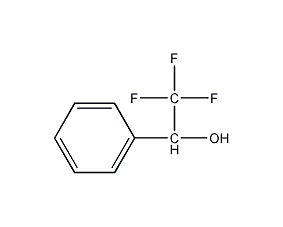1-phenyl-2,2,2-trifluoroethanol


Structural formula
| Business number | 04AM |
|---|---|
| Molecular formula | C8H7F3O |
| Molecular weight | 176.14 |
| label |
1-phenyl-2,2,2-trifluoroethanol, (±)α-(trifluoromethyl)benzylalcohol, (R,S)-2,2,2-Trifluoro-1-phenyl-ethanol, 1-Phenyl-2,2,2-trifluorethanol, Benzenemethanol,α-(trifluoromethyl)-,(±)-, α-(Trifluoromethyl)benzylalcohol, (+/-)-ALPHA-(TRIFLUOROMETHYL)BENZYLALCOHOL, ALPHA-(TRIFLUOROMETHYL)BENZYL A |
Numbering system
CAS number:340-05-6
MDL number:MFCD00004498
EINECS number:206-429-1
RTECS number:None
BRN number:3197623
PubChem ID:None
Physical property data
一 , physical property data
Traits :Not available
Density (g/mL,25/4℃): 1.297
Relative Vapor density (g/mL, air=1):Not available
Melting point (ºC): Not available
Boiling point (ºC, normal pressure):64-65
Boiling point (ºC, 5.2kPa): Not available
Refraction Rate: 1.462
Flash Point (ºC): Not available
Optical rotation (º): Not available
Spontaneous combustion Point or ignition temperature (ºC): Not available
Steam Pressure (kPa, 25ºC): Not available
saturated Vapor pressure (kPa, 60ºC): Not available
Burn Heat (KJ/mol):Not available
Critical Temperature (ºC): Not available
Critical Pressure (KPa): Not available
oil and water Log value of the (octanol/water) partition coefficient:Not available
Explosion Upper limit (%, V/V): Not available
Explosion Lower limit (%, V/V): Not available
Dissolve Properties: Not available
Toxicological data
Two , Toxicological data:
Acute Toxicity:Not available .
Ecological data
Three , Ecological data:
1 ,Other harmful effects: This substance may be harmful to the environment, and special treatment should be given to water bodies. Notice.
Molecular structure data
1. Molar refractive index: 37.79
2. Molar Volume (m3/mol):136.8
3. isotonic specific volume (90.2K):322.8
4. Surface Tension (dyne/cm): 30.9
5. Polarizability(10-24cm3):14.98
Compute chemical data
1. Reference value for hydrophobic parameter calculation (XlogP): None
2. Number of hydrogen bond donors: 1
3. Number of hydrogen bond acceptors: 4
4. Number of rotatable chemical bonds: 1
5. Number of tautomers: none
6. Topological molecule polar surface area 20.2
7. Number of heavy atoms: 12
8. Surface charge: 0
9. Complexity: 138
10. Number of isotope atoms: 0
11. Determine the number of atomic stereocenters: 0
12. Uncertain number of atomic stereocenters: 1
13. Determine the number of chemical bond stereocenters: 0
14. Number of uncertain chemical bond stereocenters: 0
15. Number of covalent bond units: 1
Properties and stability
None yet
Storage method
None yet
Synthesis method
None yet
Purpose
None yet
